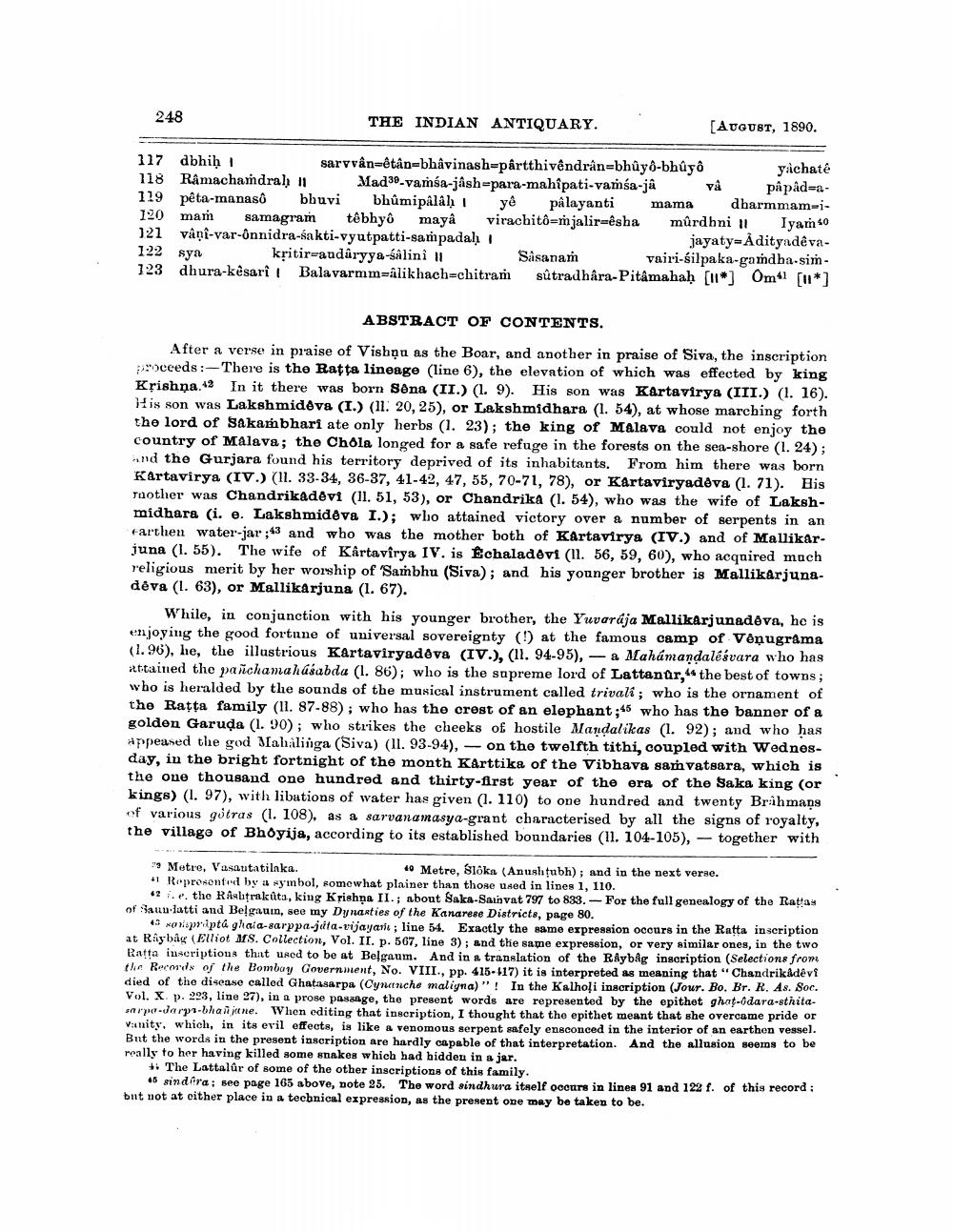________________
248
THE INDIAN ANTIQUARY.
[AUGUST, 1890.
117 dbhih 1 sarovấn=ệtập=bhavinash=pArtthiyềndrân=bhuyê-bhuyố
yichate 118 Ramachandrah 11 Mad39-vamsa-jash-para-mahîpati-vamśa-jâ và pâpâdea119 pêta-manasô bhuvi bhůmipalah yê på layanti mama dharmmam-i120 mam samagram têbhyô mayâ virachitô=mjalir=êsha mûrdhni 11 Iyam so 121 vani-var-Onnidra-sakti-vyutpatti-sampadal
jayaty=Adityadêva122 sya kritir=audûryya-salini Il Sasanaṁ vairi-silpaka-gamdha-sim123 dhura-kesari | Balavarmm=alikhach-chitram sútradhâra-Pitamahaḥ (11) Oml (11*]
ABSTRACT OF CONTENTS.
After a verse in praise of Vishğı as the Boar, and another in praise of Siva, the inscription oceeds:-There is the Ratta lineage (line 6), the elevation of which was effected by king Krishna 13 In it there was born Sena (II.) (1.9). His son was Kartavirys (III.) (1. 16). His son was Lakshmidêva (I.) (11. 20, 25), or Lakshmidhara (1. 54), at whose marching forth the lord of Sakaṁbhari ate only herbs (1. 23); the king of Malava could not enjoy the country of Malava; the Chola longed for a safe refuge in the forests on the sea-shore (1. 24); and the Gurjara found his territory deprived of its inhabitants. From him there was born Kartavirya (IV.) (II. 33-34, 36-37, 41-42, 47, 55, 70-71, 78), or Kartaviryadeva (1. 71). His Taother was Chandrikadevi (11. 51, 53), or Chandrika (1. 54), who was the wife of Lakshmidhara (i. e. Lakshmidêva I.); who attained victory over a number of serpents in an carthen water-jar;43 and who was the mother both of Kartavirya (IV.) and of Mallikar. juna (1. 55). The wife of Kârtavirya IV. is Échaladevi (11. 56, 59, 60), who acquired much religious merit by her worship of Sambhu (Siva); and his younger brother is Mallikarjuna. déva (1. 63), or Mallikarjuna (1. 67).
While, in conjunction with his younger brother, the Yuvarája Mallikarjunadáva, he is enjoying the good fortune of universal sovereignty (!) at the famous camp of Vēņugrama (1.96), he, the illustrious Kartaviryadeva (IV.), (II. 94-95), -a Mahámandalesvara who has attained the panchamahusabda (l. 86); who is the supreme lord of Lattanar, 44 the best of towns; who is heralded by the sounds of the musical instrument called trivali; who is the ornament of the Ratta family (I1. 87-88); who has the crest of an elephant ;45 who has the banner of a golden Garuda (1. 90); who strikes the cheeks of hostile Mandalikas (1. 92); and who has appeased the god Mahalinga (Siva) (11. 93-94), – on the twelfth tithi, coupled with Wednesday, in the bright fortnight of the month Karttika of the Vibhava samvatsara, which is the one thousand one hundred and thirty-first year of the era of the Saka king (or kings) (1. 97), with libations of water has given (1. 110) to one hundred and twenty Brahmans of various götras (1. 108), as a sarvanamasya-grant characterised by all the signs of royalty, the village of Bhoyija, according to its established boundaries (11. 104-105), - together with
9 Metre, Vasantatilaka.
49 Metre, Blóka (Anushubh); and in the next verse. +1 Represented by a symbol, somewhat plainer than those used in lines 1, 110.
2. the Rashtrakūta, king Krishna II.; about Saka-Sauvat 797 to 833. For the full genealogy of the Rattas of Sauulatti and Belgauin, see my Dynasties of the Kanarese Districte, page 80.
45 xoxispripta ghaia-sarppa-juta-vijayant ; line 54. Exactly the same expression occurs in the Ratta inscription at Raybag Elliot Ms. Collection, Vol. II. p. 567, line 3); and the same expression, or very similar ones, in the two Ratta inscriptions that used to be at Belgaum. And in a translation of the RAybar inscription (Selections from the Records of the Bombay Government, No. VIII., PP. 415--17) it is interpreted as meaning that "Chandrikadevi died of the disease called Ghatasarpa (Cynanche maliyna)" ! In the Kalhoļi inscription (Jour. Bo. Br. R. As. Soc. Vol. X p. 223, line 27), in a prose pasange, the present words are represented by the epithet ghat-dara-sthitasarpo-darpa-bha i june. When editing that inscription, I thought that the epithet meant that she overcame pride or Vanity, which, in its evil effects, is like a venomous serpent safely ensconced in the interior of an earthen vessel. But the words in the present inscription are hardly capable of that interpretation. And the allusion seems to be really to her having killed some snakes which had hidden in a jar.
* The Lattalar of some of the other inscriptions of this family.
45 sindira: see page 165 above, note 85. The word sindhura itaelf oocura in linea 91 and 122 f. of this record; but not at either place in a technical expression, as the present one may be taken to be.




